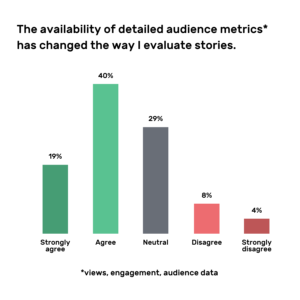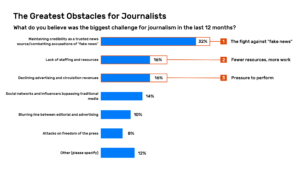Did you know thousands of journalists are surveyed every year about their industry and how they view public relations (PR)? The data shows a little bit of everything: pain points, preferences and trends that are surfacing within the media industry. These surveys are collaborative, often endorsed by highly respected journalistic institutions, and provide great insight into the evolution of modern media when looked at year over year. When taken into account, the data provides PR professionals an opportunity to become a trusted resource for journalists, resulting in greater success of your media intentions.
You may not have time to read through the data – so we’ve done it for you. We reviewed two recently published reports conducted by Muck Rack, a leading platform for public relations management, and Cision, the industry’s go-to resource for media outreach. For the most part, the data align; the main exception focuses on the effectiveness of the traditional press release, which could very well become a debate akin to the oxford comma war we often find ourselves in.
IS THE PRESS RELEASE DEAD?
In case you missed it, we actually talked about this in-depth a few months back. In short, press releases are still considered a good tactic to promote newsworthy topics and can be very effective. However, building one-on-one relationships and sending short media pitches is becoming more effective. Journalists want to know that you’ve done your homework and are sending them relevant information that aligns with their areas of interest. If their beat happens to be local area politics, sending them a media pitch to cover your charity event is probably not a good fit. Additionally, being concise, to the point, and providing answers to those anticipated questions will always result in greater success of your story being picked up.
WHERE PR AND JOURNALISM COME TOGETHER
There was a time when journalists didn’t feel that much pressure to appease their audiences. However, as cords are cut and media distrust is at an all-time high, the very few journalists remaining are under a lot of pressure to attract audiences and drive engagement through likes, shares, clicks, and video plays. Sounds like a PR job, right? Cision’s media report says in 2022, journalists are in fact feeling more pressure than ever before to drive audience engagement through likes, shares, clicks, and video plays. If a PR professional comes to a journalist with a story that has engagement potential, there’s a high chance the pitch will get some kind of consideration.
Not only that, but 22 percent of journalists explicitly stated that publicists can do them a favor by including multimedia content in their pitches and with their press releases, with 54 percent reporting that they would be more likely to cover a story if multimedia elements are included.
Source: Cision 2022
EMPATHY AND UNDERSTANDING
Most journalists don’t seek their career path to make the big bucks; instead, they do it as more of a calling that enables them to engage in storytelling in the hopes of making a difference in the world. In fact, it’s well known that journalists forego having families because of the long hours and subpar pay that most environments provide. Given the current economy and ample job opportunities outside of journalism, the media industry is in a state of decline. Newsrooms cannot retain top talent and are losing staff at an alarming rate.
Cision reports that the second biggest challenge (compared to the credibility and declining reputation of mainstream media) for journalists over the last 12 months revolves around a lack of staffing and resources. Cision’s survey found that 29 percent of reporters file 10 or more stories a week, with 43 percent covering five beats or more. In contrast to the days when reporters covered a particular beat, or area of focus, most do a little bit of everything due to the shortage of resources.
The ProTip here is to exercise empathy if you want to engage a journalist. Understand that their time and resources are limited – having all the needed elements ready and the right people lined up for a story can be a game changer. For example, if you want a story to get picked up about that charity event we mentioned earlier, include a high res photo or two, a high res logo of the sponsoring organization, a meaningful quote and someone lined up for an interview, should the request arise. 22 percent of journalists expressed appreciation when provided with additional multimedia content that supplements a pitch and/or press releases, and Cision reports that those stories with multiple images are 6x more engaging when published/considered for pickup. They need and will gladly take any help they can get.
Source: Cision 2022
JOURNALISTS DON’T HAVE TIME FOR MARKETING BUZZWORDS
While PR can be an effective marketing tool, don’t expect a journalist to say Company XYZ is the leading human resources provider in the market. If you have a release or a pitch that is loaded with buzz words such as Innovative, Revolutionary, Groundbreaking, Unique, or everyone’s favorite, Leading – you are likely going to be ignored – and if they do pick up your story, be prepared for those buzz words being removed. Keep it simple, and let the “why” or solution of your media outreach speak for itself with unbiased facts and information.
The insights above just scratch the surface of the data points available to PR professionals. By tapping into the potential of well-done PR, you’ll be able to not only get your message out more effectively but also establish yourself as a reliable and trustworthy source of information. Flourish stays ahead of the curve and is always looking at the State of the Media. Reach out if you need help wrapping your head around earned media going into 2023.


